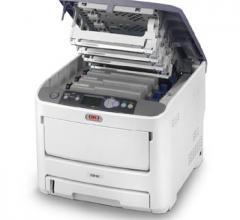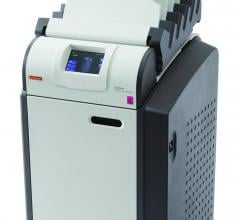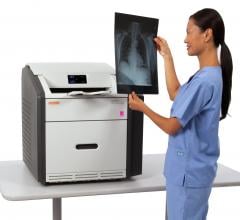
Codonics' Horizon Ci
In spite of radiology’s rapid evolution to a digital world, many clinicians still rely heavily on film and most likely will continue doing so into the foreseeable future. To them, computer bytes do not yet serve as a substitute for hard copy.
That said, an imaging modality’s ability to accurately image anatomical structures is only as good as their output – on screen or in film. After a brief period of catch-up, today’s laser imagers, which effectively supplanted archaic wet processing systems more than a decade ago, are smaller, faster, more powerful and more versatile than ever before. Moreover, these imaging machines are producing images with eye-popping clarity.
Multimedia Workhorses
Laser imagers perform the work their bulky (and some would argue messy) wet film predecessors did several years ago. Many observers agree they are doing so admirably.
“Hospitals, imaging centers and clinics all require a certain level of film printing for CR/DR, ultrasound, MR, CT and digital mammography,” said Steven Eisner, marketing manager for Digital Products, for Wayne, NJ-based Konica Minolta Medical Imaging. Lower-end machines can also be used for printing reference films for referring physicians, patient records, teaching and follow-up exams.
“Since most imaging centers offer many imaging systems – including MRI, CT, CR, DR, FFDM and ultrasound – laser imagers need to support networked output onto the preferred radiographic film size for all these modalities,” added Kurt Seestrom, product manager for Digital Output, Carestream Health, Rochester, NY. Seestrom said some imaging centers might also link a printer to a specific modality to expedite workflow in a busy area.
As reliable as they are in producing diagnostic quality films, many current laser imaging systems are full multimedia machines, capable of also printing a wide variety of documents on paper as well.
Litany of Benefits
While “old school” radiological veterans sing the praises of analog film, the list of benefits of laser imager-produced films grows longer every day. To wit:
• Cost effective. Dry laser imagers are known to have longer life spans than wet processors, and user maintenance usually only entails changing toner cartridges, instead of disposing of hazardous processing chemicals. Laser diodes usually are the one component that needs replacing, and recent innovations have made them very reliable. “As more and more clinical systems support color, we’ll see an increased use of color laser imagers,” said Jason Hanson, industry healthcare consultant for Lexington, KY-based Lexmark. Moreover, he added, the cost of laser printing has gone down dramatically in the past few years.
• Speed. Laser imagers today can churn out literally hundreds of films per hour, a huge plus for burgeoning outpatient imaging centers. Faster machines have also improved overall throughput and productivity.
• Archiving. High-tech inks and encapsulated dyes allow laser films to last significantly longer than their analog predecessors because of improved emulsions and processing. Moreover, most laser films today are less sensitive to temperature changes and can be opened in daylight, making it easier to change loading trays.
• Versatility. Many imagers today are capable of outputting films from a wide variety of imaging modalities. “The primary applications still include CT and MRI because of the number of sheets of film per procedure,” said Jim McLain, senior marketing manager, Hardcopy Solutions, Agfa HealthCare, Allen, TX. “More recently, with the rapid conversion from conventional X-ray to CR/DR, there has been an increase in usage for printing CR/DR images. Also with the conversion from conventional mammography to full field digital mammography (FFDM), the demand for imagers capable of printing the high-resolution FFDM images has increased.”
• Small footprint. Unlike wet processors, many laser imagers today are remarkably small, an attractive feature for space-deprived outpatient imaging centers. This also allows them to be easily relocated from one room to another. For example, Konica Minolta touts its DryPro 832, introduced earlier this year, as the smallest laser dry film imager on the market, occupying a paltry four square feet of table or floor space. Codonics says that its Horizon XL multimedia imager also can fit in tight spaces, requiring only two feet of space on any counter top. Sony Medical’s FilmStation dry film imager is the only imager of its kind that can be installed either in the upright vertical position or horizontally and is so compact that it can be placed on a desktop in a traditional X-ray viewing room or in an empty slot beneath a doctor’s desk. Moreover, several laser imagers on the market also are capable of going on the road. FUJIFILM Medical Systems’ DryPix 2000, for example, has an available mobile kit that allows it to be used in imaging vans, said John Strauss, director of Marketing, Imaging Systems for the Stamford, CT-based company.
What Buyers Seek
What are buyers in the outpatient arena looking for in laser imagers?
“Busy staffs prefer reliable printers that offer easy maintenance,” said Seestrom. “In this environment, outpatient facilities need a fast, reliable laser imager that delivers rapid, high-quality output. Due to cost and competitive pressures, centers are also looking for affordability and a small footprint.”
Price and cost of ownership are also big. According to Hanson, one to three percent of any organization’s bottom line revenue can be attributed to expenses for printers and toner. “Many have no idea what it’s costing them to print images. Go in any healthcare facility and you’ll see a wide array of disparate printers scattered all over the place. Outpatient facilities really need to take a close look at what their film and printing is costing. It would be eye-opening,” Hanson noted.
“Outpatient buyers are looking for cost-effective solutions, especially with the Deficit Reduction Act changes in reimbursement,” added Julie Holodak, marketing manager, Radiology Market, Sony Medical, Park Ridge, NJ. “Most outpatient facilities also are looking at the long-term cost of ownership.”
According to Strauss, most outpatient facilities are able to hold on to laser imaging equipment for as long as five years. “They aren’t as technology dependent as they used to be,” he said.
Still, “maintenance and reliability are what differentiates everyone,” Strauss added, “and many buying decisions are being made on those two things.” Print heads and their expensive laser diodes normally are the first item that need replacing, and they can be expensive. Some companies warranty their print heads for a certain number of prints or years in use, whichever comes first.
While he acknowledges that price is playing “a larger role” in buying decisions, McLain asserts that throughput and resolution are still paramount, particularly for high-resolution dependent digital mammography.
“Image quality is usually a big factor for digital mammography and other modalities only when the customer has an opportunity to do a side-by-side comparison between films from the imagers,” added Eisner.
Buyers also are looking for imagers that can multi-task, printing color and grayscale film in a wide variety of sizes, reports, and even add-on accessories such as CD and DVD burners. “Film-only imagers are antiquated technology,” said Cristy Granger, marketing manager for Middleburg Heights, OH-based Codonics, which offers its all-in-one Horizon multimedia dry imager as a single solution for the network and picture archiving and communication systems (PACS) environment with film, color paper and grayscale paper – all online.
Lexmark’s Clinical Assistant multifunction printer, which incorporates four lasers in one print head, can print color lab reports and MRI, CT, ultrasound and nuclear medicine images. “This has allowed us to make printers with a smaller footprint, all the while with increased image quality and speed,” said Hanson.
Smaller outpatient centers may prefer decentralized laser imagers for their mobility and ability to serve single imaging systems. But since many laser imagers serve multiple modalities at the same time, network connectivity is a big issue because of the need to print films from various workstations and PACS. “Today, many facilities are network film printing from PACS,” said Strauss. Centralized printing is very big right now.
A Look Under the Hood
Most laser imagers today are self-calibrating (user interfaces are common) and offer features such as hard drives and on-board memory for storing digital files, multiple bins to accommodate various film sizes (Codonics reports that its Horizon systems can hold up to 300 sheets of film), sorters, security and remote diagnostics that allow users to troubleshoot printers from remote locations.
A closer look under the hood at common specs reveals myriad features:
• Inputs. Many offer ports for multiple Digital Imaging and Communications in Medicine (DICOM) connections. For example, Konica Minolta’s DryPro 751 and 752 support 16 DICOM channels.
• Resolution. Typically measured in pixels per inch (also called “dpi”), laser imager print resolution varies by film size. Spatial resolution is measured in pixels per inch by microns, and contrast ratios are measured in shades of gray and bits. Look for imagers capable of high dpi and black levels. Some Codonics’ imagers and the Sony FilmStation feature 320 dpi and 4,096 shades of gray; Agfa’s Drystar Axys tabletop imager offers an image resolution of 508 dpi, while Carestream’s Kodak DryView 8900 laser imaging system delivers 650 dpi on both mammography and general radiography exams and 16,384 possible levels of gray.
• Film sizes. Depending on the company, laser imagers support film sizes of 8-by-10, 10-by-12, 11-by-14, 14-by-14 and 14-by-17. Codonics states that its Horizon XL multi-media dry imager offers the world’s only 14-by-36 and 14-by-51 long film for orthopedic applications such as CR/DR.
• Print time. Most laser imagers are capable of pumping out a remarkable 120 films per hour (the larger the film, the fewer per hour output). Some companies differentiate themselves by the time their printer takes to ramp up for printing that first image. Ninety seconds is the norm, but many imagers are beating that time. Eisner said Konica Minolta’s redesigning the film path and key imaging components of the DryPro 832 make it the fastest imager in the market. The first film comes out in 50 seconds. Carestream claims that its Kodak DryView 8900 operates at full rated speed of up to 200 films per hour.
• Print management. Many laser imagers today come with sophisticated print management capabilities that allow them to juggle disparate data. Some print management systems (such as FUJIFILM’s DryPix Link, Carestream’s PACS Link and Konica Minolta’s Printlink II) can even convert image signal output from various nonDICOM modalities.
Wet is Dead, but will Film one Day be?
Most companies have adapted well to the decline of wet film processing and the explosion of all things digital. But will dry film suffer the same fate? After all, the advent of PACS, in fact its very raison d’etre, is the elimination of physical paper and film.
“Film printing is declining because clinicians are relying more and more on soft copy,” said Eisner. “Therefore, the importance of film-only imagers is also declining. I think we will see this trend continue. However, what newer technology does bring is a more cost effective solution even for those facilities printing little. The newer imagers take up less space, cost less to maintain, and are easier to use. These add up to good reasons to replace old imagers with new ones despite the waning film requirement.”
Added Seestrom: “Like hospitals, imaging centers are replacing film with digital image and information management systems. Many centers have used digital modalities for some time and are now installing or upgrading PACS and RIS. Even though many centers are focused on eliminating as much paper and film as possible, most still need to print some imaging studies to meet the needs of patients, surgeons, referring physicians and others. As the population ages, the demand for radiographic imaging is exploding and many imaging centers are seeing double-digit annual growth in imaging volumes.”
No matter the size of a facility or the complexity of a radiology infrastructure, hard- copy images continue to be an extremely valuable and often irreplaceable, diagnostic tool, according to Agfa. And until going completely digital becomes an easy decision for even the smallest outpatient care facility, film will remain viable. Said McLain, “With the rapid conversion to PACS, the need for hard copy imaging has decreased, but it remains a strong market.”
Holodak agrees. “More and more facilities are going film-less,” she said. “Still, there’s a very big need for hard copy output, especially in orthopedic imaging. Moreover, a lot of outpatient facilities still can’t afford PACS.”



 September 19, 2016
September 19, 2016 





